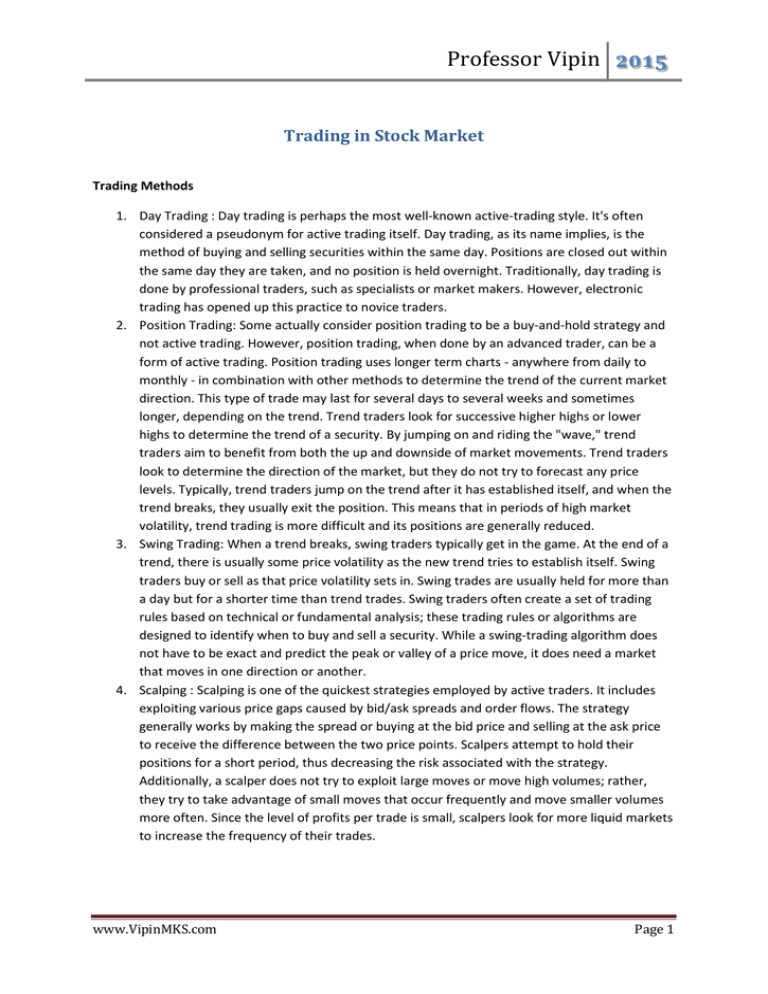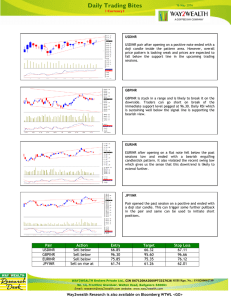Professor Vipin 2015 Trading in Stock Market
advertisement

Professor Vipin 2015 Trading in Stock Market Trading Methods 1. Day Trading : Day trading is perhaps the most well-known active-trading style. It's often considered a pseudonym for active trading itself. Day trading, as its name implies, is the method of buying and selling securities within the same day. Positions are closed out within the same day they are taken, and no position is held overnight. Traditionally, day trading is done by professional traders, such as specialists or market makers. However, electronic trading has opened up this practice to novice traders. 2. Position Trading: Some actually consider position trading to be a buy-and-hold strategy and not active trading. However, position trading, when done by an advanced trader, can be a form of active trading. Position trading uses longer term charts - anywhere from daily to monthly - in combination with other methods to determine the trend of the current market direction. This type of trade may last for several days to several weeks and sometimes longer, depending on the trend. Trend traders look for successive higher highs or lower highs to determine the trend of a security. By jumping on and riding the "wave," trend traders aim to benefit from both the up and downside of market movements. Trend traders look to determine the direction of the market, but they do not try to forecast any price levels. Typically, trend traders jump on the trend after it has established itself, and when the trend breaks, they usually exit the position. This means that in periods of high market volatility, trend trading is more difficult and its positions are generally reduced. 3. Swing Trading: When a trend breaks, swing traders typically get in the game. At the end of a trend, there is usually some price volatility as the new trend tries to establish itself. Swing traders buy or sell as that price volatility sets in. Swing trades are usually held for more than a day but for a shorter time than trend trades. Swing traders often create a set of trading rules based on technical or fundamental analysis; these trading rules or algorithms are designed to identify when to buy and sell a security. While a swing-trading algorithm does not have to be exact and predict the peak or valley of a price move, it does need a market that moves in one direction or another. 4. Scalping : Scalping is one of the quickest strategies employed by active traders. It includes exploiting various price gaps caused by bid/ask spreads and order flows. The strategy generally works by making the spread or buying at the bid price and selling at the ask price to receive the difference between the two price points. Scalpers attempt to hold their positions for a short period, thus decreasing the risk associated with the strategy. Additionally, a scalper does not try to exploit large moves or move high volumes; rather, they try to take advantage of small moves that occur frequently and move smaller volumes more often. Since the level of profits per trade is small, scalpers look for more liquid markets to increase the frequency of their trades. www.VipinMKS.com Page 1 Professor Vipin 2015 Settlement Settlement of securities is a business process whereby securities or interests in securities are delivered, usually against (in simultaneous exchange for) payment of money, to fulfill contractual obligations, such as those arising under securities trades. In the U.S., the settlement date for marketable stocks is usually 3 business days or T+3 after the trade is executed, and for listed options and government securities it is usually 1 day after the execution. In Europe, settlement date has recently been adopted as 2 business days settlement cycles T+2. As part of performance on the delivery obligations entailed by the trade, settlement involves the delivery of securities and the corresponding payment. A number of risks arise for the parties during the settlement interval, which are managed by the process of clearing, which follows trading and precedes settlement. Clearing involves modifying those contractual obligations so as to facilitate settlement, often by netting and novation. Settlement Process NSCCL carries out clearing and settlement functions as per the settlement cycles provided in the settlement schedule. The clearing function of the clearing corporation is designed to work out a) what members are due to deliver and b) what members are due to receive on the settlement date. Settlement is a two way process which involves transfer of funds and securities on the settlement date. NSCCL has also devised mechanism to handle various exceptional situations like security shortages, bad delivery, company objections, auction settlement etc. Clearing is the process of determination of obligations, after which the obligations are discharged by settlement. NSCCL has two categories of clearing members: trading clearing members and custodians. Trading members can trade on a proprietary basis or trade for their clients. All proprietary trades become the member’s obligation for settlement. Where trading members trade on behalf of their clients they could trade for normal clients or for clients who would be settling through their custodians. Trades which are for settlement by Custodians are indicated with a Custodian Participant (CP) code and the same is subject to confirmation by the respective Custodian. The custodian is required to confirm settlement of these trades on T + 1 day by the cut-off time 1.00 p.m. Non-confirmation by custodian devolves the trade obligation on the member who had input the trade for the respective client. A multilateral netting procedure is adopted to determine the net settlement obligations (delivery/receipt positions) of the clearing members. Accordingly, a clearing member would have either pay-in or pay-out obligations for funds and securities separately. In the case of securities in the Trade for Trade – Surveillance segment and auction trades, obligations are determined on a gross basis i.e. every trade results into a deliverable and receivable obligation of funds and www.VipinMKS.com Page 2 Professor Vipin 2015 securities. Members pay-in and pay-out obligations for funds and securities are determined by 2.30 p.m. on T + 1 day and are downloaded to them so that they can settle their obligations on the settlement day (T+2). Speculation The act of trading in an asset, or conducting a financial transaction, that has a significant risk of losing most or all of the initial outlay, in expectation of a substantial gain. With speculation, the risk of loss is more than offset by the possibility of a huge gain; otherwise, there would be very little motivation to speculate. While it is often confused with gambling, the key difference is that speculation is generally tantamount to taking a calculated risk and is not dependent on pure chance, whereas gambling depends on totally random outcomes or chance. Types of Speculation Four kinds of speculators operate in the Indian Stock Exchange. They are known as bull, bear, stag and lame duck. A Bull also called as Tejiwala is an operator who is hopeful of price rise in the near future. In anticipation of price rise he makes purchases of shares and other securities with the intention of selling them at higher prices in future. He being a speculator has no intention of taking delivery of securities but deals only in difference of prices. As a bull is famous for throwing up the opponent in the air, similarly a bull speculator also takes the price of securities high up in the air. He does this by placing high-value purchase orders. A bear or a Mandiwala on the other hand is a speculator who is wary of fall in prices and hence sells securities so that he may buy them at cheap price in future. A bear does not have securities at present but sells them at higher prices in anticipation that he will supply them business purchasing at lower prices in the future. If the prices move down as per the expectations of the bear he will earn profits out of these transactions. Just as a bear presses his victims down to the ground, the bear speculator tends to force down the prices of different securities. It so happens that when bearish operators are bent upon selling securities, the prices also automatically come down. It is a usual practice that a bear is not interested in taking the delivery of securities but he is desirous of getting the variation in prices, provided the prices come down. In case prices rise then he will have to pay the difference between the prices at which he purchased the securities and the prevailing prices on the date of delivery. Then comes a stag. A stag is that type of speculator who treads his path very carefully. He applies for shares in new companies and expects to sell them at a premium if he gets an allotment. He selects those companies whose shares are most in demand and are likely to carry a premium. He sells the shares before being called to pay the allotment money. A stag does not indulge in purchase and sale of shares in the market like a bull and a bear. A Lame Duck is nothing but a stressed bear. When a bear finds it difficult to complete his promise he is labeled as a lame duck. NSDL and CSDL At present two Depositories viz. National Securities Depository Limited (NSDL) and Central Depository Services (I) Limited (CDSL) are registered with SEBI. A depository is an organisation which www.VipinMKS.com Page 3 Professor Vipin 2015 holds securities of investors in electronic form at the request of the investors through a registered Depository Participant. It also provides services related to transactions in securities. A Depository Participant (DP) is an agent of the depository through which it interfaces with the investor. A DP can offer depository services only after it gets proper registration from SEBI. Banking services can be availed through a branch whereas depository services can be availed through a DP. The benefits are enumerated below: A safe and convenient way to hold securities; Immediate transfer of securities; No stamp duty on transfer of securities; Elimination of risks associated with physical certificates such as bad delivery , fake securities, delays, thefts etc.; Reduction in paperwork involved in transfer of securities; Reduction in transaction cost; No odd lot problem, even one share can be sold; Nomination facility; Change in address recorded with DP gets registered with all companies in which investor holds securities electronically eliminating the need to correspond with each of them separately; Transmission of securities is done by DP eliminating correspondence with companies; Automatic credit into demat account of shares, arising out of bonus/split/consolidation/merger etc. Holding investments in equity and debt instruments in a single account. www.VipinMKS.com Page 4




